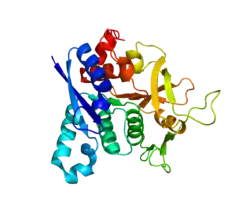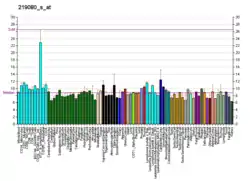CTPS2
CTP synthase 2 is an enzyme that in humans is encoded by the CTPS2 gene.[5][6]
The protein encoded by this gene catalyzes the formation of CTP from UTP with the concomitant deamination of glutamine to glutamate.
This protein is the rate-limiting enzyme in the synthesis of cytosine nucleotides, which play an important role in various metabolic processes and provide the precursors necessary for the synthesis of RNA and DNA. Cancer cells that exhibit increased cell proliferation also exhibit an increased activity of this encoded protein.
Thus, this protein is an attractive target for selective chemotherapy. Two alternatively spliced transcript variants encoding the same protein have been described for this gene.[6]
References
- GRCh38: Ensembl release 89: ENSG00000047230 - Ensembl, May 2017
- GRCm38: Ensembl release 89: ENSMUSG00000031360 - Ensembl, May 2017
- "Human PubMed Reference:". National Center for Biotechnology Information, U.S. National Library of Medicine.
- "Mouse PubMed Reference:". National Center for Biotechnology Information, U.S. National Library of Medicine.
- van Kuilenburg AB, Meinsma R, Vreken P, Waterham HR, van Gennip AH (Oct 2000). "Identification of a cDNA encoding an isoform of human CTP synthetase". Biochim Biophys Acta. 1492 (2–3): 548–52. doi:10.1016/s0167-4781(00)00141-x. PMID 10899599.
- "Entrez Gene: CTPS2 CTP synthase II".
External links
- Human CTPS2 genome location and CTPS2 gene details page in the UCSC Genome Browser.
Further reading
- Olsen JV, Blagoev B, Gnad F, et al. (2006). "Global, in vivo, and site-specific phosphorylation dynamics in signaling networks". Cell. 127 (3): 635–48. doi:10.1016/j.cell.2006.09.026. PMID 17081983.
- Rual JF, Venkatesan K, Hao T, et al. (2005). "Towards a proteome-scale map of the human protein-protein interaction network". Nature. 437 (7062): 1173–8. doi:10.1038/nature04209. PMID 16189514.
- Han GS, Sreenivas A, Choi MG, et al. (2006). "Expression of Human CTP Synthetase in Saccharomyces cerevisiae Reveals Phosphorylation by Protein Kinase A". J. Biol. Chem. 280 (46): 38328–36. doi:10.1074/jbc.M509622200. PMC 1400552. PMID 16179339.
- Ross MT, Grafham DV, Coffey AJ, et al. (2005). "The DNA sequence of the human X chromosome". Nature. 434 (7031): 325–37. doi:10.1038/nature03440. PMC 2665286. PMID 15772651.
- Gerhard DS, Wagner L, Feingold EA, et al. (2004). "The Status, Quality, and Expansion of the NIH Full-Length cDNA Project: The Mammalian Gene Collection (MGC)". Genome Res. 14 (10B): 2121–7. doi:10.1101/gr.2596504. PMC 528928. PMID 15489334.
- Ota T, Suzuki Y, Nishikawa T, et al. (2004). "Complete sequencing and characterization of 21,243 full-length human cDNAs". Nat. Genet. 36 (1): 40–5. doi:10.1038/ng1285. PMID 14702039.
- Strausberg RL, Feingold EA, Grouse LH, et al. (2003). "Generation and initial analysis of more than 15,000 full-length human and mouse cDNA sequences". Proc. Natl. Acad. Sci. U.S.A. 99 (26): 16899–903. doi:10.1073/pnas.242603899. PMC 139241. PMID 12477932.
This article is issued from Wikipedia. The text is licensed under Creative Commons - Attribution - Sharealike. Additional terms may apply for the media files.





